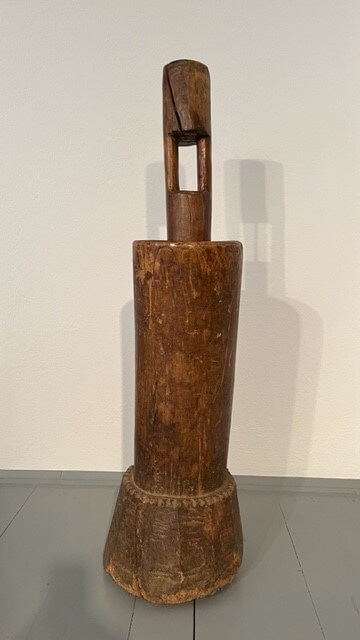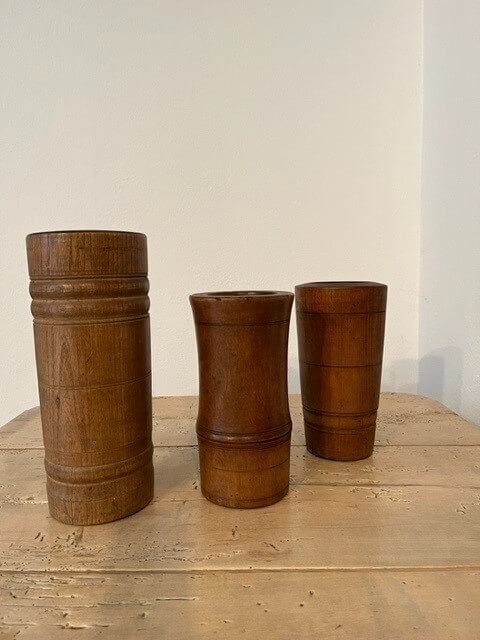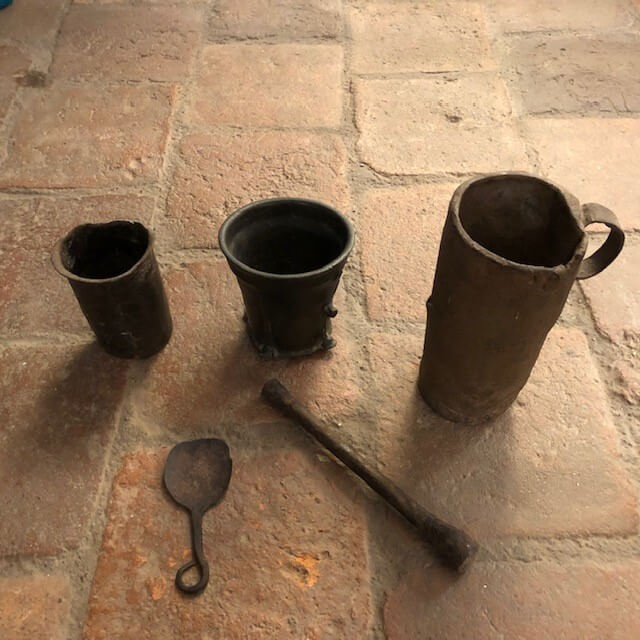…. a vessel and a tool
The mortar is used to crush food and grind substances for ritual, cosmetic or medicinal purposes. The size and material of the mortar determine which substance is to be processed and the degree of granulation to be achieved. Originally, mortars were made of natural materials such as stone, wood, ivory or horn – just as primitive peoples still do today.  Hardwood was preferably used because the material must withstand a robust working process and the porosity is lower than softwood. To be able to reuse the mortar, the surface must not absorb any substance. For pounding or crushing soft or succulent foods, I have seen softwood mortars in the Innsbruck Folklore Museum as an exception. Poppy pounders made of soft wood can be seen there.
Hardwood was preferably used because the material must withstand a robust working process and the porosity is lower than softwood. To be able to reuse the mortar, the surface must not absorb any substance. For pounding or crushing soft or succulent foods, I have seen softwood mortars in the Innsbruck Folklore Museum as an exception. Poppy pounders made of soft wood can be seen there.  The tool used for crushing is called a pestle, pestle or pestle. Usually one pole of the pestle is rounded and the other is flattened. Unfortunately, it is usually missing. The activity on the mortar presupposes a working height that allows the most effective crushing with the optimum use of force.
The tool used for crushing is called a pestle, pestle or pestle. Usually one pole of the pestle is rounded and the other is flattened. Unfortunately, it is usually missing. The activity on the mortar presupposes a working height that allows the most effective crushing with the optimum use of force.  The movement is a pitching and twisting motion. If the material was particularly coarse and solid, the exhausting work with the heavy pestle was made easier by suspending it on a bow, spring or similar stirrup device, which could be very primitive, but proved efficient. Besides the natural materials, there are man-made materials. First of all, bronze was used for mortar production. Besides, also brass, porcelain or glass. Bronze mortars were often used for coarse materials for preliminary crushing.
The movement is a pitching and twisting motion. If the material was particularly coarse and solid, the exhausting work with the heavy pestle was made easier by suspending it on a bow, spring or similar stirrup device, which could be very primitive, but proved efficient. Besides the natural materials, there are man-made materials. First of all, bronze was used for mortar production. Besides, also brass, porcelain or glass. Bronze mortars were often used for coarse materials for preliminary crushing.  Because of their susceptibility to corrosion, they were also used only for processing dry and chemically neutral substances. The manufacturing costs were relatively high even for a simple mortar. As a working tool, they were part of the valuable equipment in the household and in the pharmacy and were even recorded in inventory lists. Mortars are a symbol of the apothecary guild. Showpieces depending on the material represented a small fortune. Anyone who owned a mortar treasured it and passed it on from generation to generation.
Because of their susceptibility to corrosion, they were also used only for processing dry and chemically neutral substances. The manufacturing costs were relatively high even for a simple mortar. As a working tool, they were part of the valuable equipment in the household and in the pharmacy and were even recorded in inventory lists. Mortars are a symbol of the apothecary guild. Showpieces depending on the material represented a small fortune. Anyone who owned a mortar treasured it and passed it on from generation to generation.

